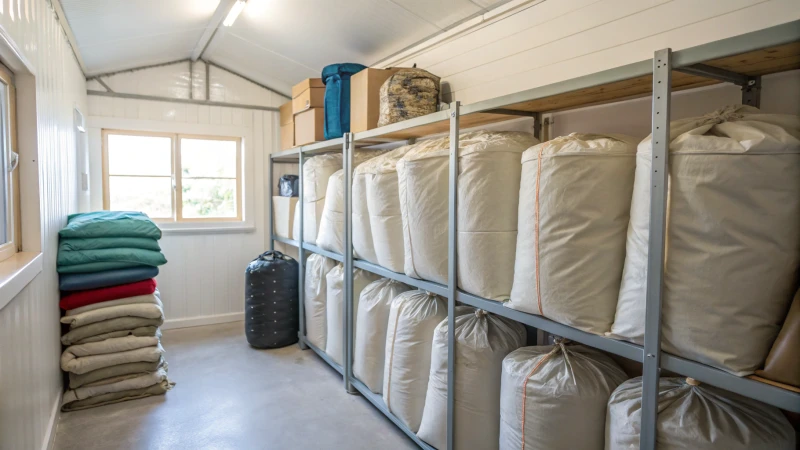
Ever watched your tent battle against wind and rain, holding strong through it all? That’s the power of well-maintained fabric.
To keep tent fabric in top shape, regularly clean it, avoid sharp objects, promptly repair any damage, and store it properly. These steps are key to prolonging its life and functionality.
Maintaining tent fabric isn’t just about extending its life—it’s about preserving memories. I remember a camping trip where a sudden downpour tested my tent’s resilience. Thanks to diligent maintenance, it stood firm, keeping us dry and safe. Dive into the detailed strategies below to make sure your tent is always ready for the next adventure.
Regular cleaning extends tent fabric life.True
Cleaning removes dirt and debris that can degrade fabric over time.
Sharp objects do not affect tent fabric durability.False
Sharp objects can tear or puncture the fabric, reducing its durability.
How Often Should You Clean Your Tent Fabric?
Ever come back from a camping trip with a muddy, rain-soaked tent? I’ve been there! Keeping your tent clean not only helps it last longer but also makes your outdoor adventures more enjoyable.
Clean your tent fabric at least once a season or after every major trip. This prevents dirt buildup and extends the tent’s lifespan, ensuring it stays functional and pleasant for your next adventure.

Understanding Tent Fabric Maintenance
Let me tell you, the first time I unrolled my tent after a long winter, I was shocked at how dusty it had become. That’s when I realized the importance of seasonal cleaning. If you’re like me and camp often, especially in varied conditions, giving your tent a good scrub at least once a season can be a game-changer. For those who prefer the occasional weekend getaway, a thorough cleaning after every few uses might just do the trick.
Factors Influencing Cleaning Frequency
Usage Patterns: Have you ever returned from a trip where the dust was so thick you could taste it? I have, and those are the times your tent needs extra attention. If you’re camping in such environments often, it’s wise to adjust your cleaning routine accordingly.
Environmental Conditions: Remember that time you camped by the beach, and sand found its way into everything? Regular cleaning is crucial after these trips. A quick post-trip check can reveal when it’s time for a thorough wash1.
| Condition | Recommended Action |
|---|---|
| Heavy Rain | Dry and clean promptly |
| Sandy Areas | Shake off sand, rinse |
| Muddy Grounds | Wash off mud immediately |
Effective Cleaning Techniques
I’ve learned the hard way that simply packing away a dirty tent is a recipe for disaster. After each adventure, I make it a point to rinse off any surface dirt. Stubborn spots might need a gentle brush. And trust me, making sure it’s completely dry before storing is key to avoiding unpleasant mildew surprises.
- Rinse Before Storage: After each trip, rinse the tent fabric to remove surface dirt. Use a gentle brush for stubborn spots.
- Dry Completely: Ensure the fabric is completely dry before storing to prevent mildew growth.
- Avoid Harsh Cleaners: Stick to mild soaps as harsh chemicals can degrade the fabric’s protective coatings.
Storing Your Tent Correctly
Storing your tent properly is just as important as cleaning it. I’ve found that keeping it in a cool, dry place works wonders in maintaining its condition. Every now and then, I check for any signs of mold or damage to stay ahead of any issues. If you’re looking for more on proper tent storage2, expert guides are invaluable.
By following these steps and maintaining a consistent cleaning routine, you’ll ensure your tent not only lasts longer but also provides you with countless comfortable nights under the stars.
Tents in sandy areas need cleaning after each use.True
Sand can damage fabric and zippers if not removed promptly.
Harsh cleaners are recommended for stubborn stains.False
Harsh chemicals can degrade the tent's protective coatings.
What Products Are Best for Cleaning Tent Fabric?
Ever found yourself knee-deep in mud after a rainy camping trip, only to realize your tent fabric looks like it survived a battlefield?
The best products for cleaning tent fabric include mild soaps, specialized tent cleaners, and soft brushes. Avoid harsh chemicals to prevent damage. Regular cleaning helps maintain the fabric’s waterproof and UV-resistant properties.

I remember one summer, returning from a week-long camping trip with my family. Our tent was a disaster—a canvas of dirt, mud, and mystery stains. I knew then that finding the right cleaning products was crucial not just for the tent’s appearance, but for its longevity and performance.
Gentle Soaps and Detergents
From my experience, gentle soaps are a lifesaver when it comes to cleaning tent fabric. I usually go with regular dish soap mixed with warm water—it’s mild yet effective at lifting away grime without causing harm to the fabric. Just make sure the soap doesn’t contain harsh chemicals or bleach, as these can really do a number on your tent.
Specialized Tent Cleaners
If you’re like me and want to use something specifically designed for tents, there are plenty of options. These specialized cleaners are great because they’re formulated to preserve the integrity of the fabric3 while efficiently tackling stains. Plus, they often come with easy-to-follow instructions on dilution and application.
Soft Brushes and Cloths
When it comes to scrubbing off stubborn dirt, the right tools make all the difference. I’ve learned that using soft-bristled brushes or cloths can gently remove grime without scratching or tearing the fabric. This method has saved many a tent from premature retirement in my household.
| Product | Type | Use Case |
|---|---|---|
| Mild Soap | General Cleaner | Everyday dirt removal |
| Tent Cleaner | Specialized Agent | Deep cleaning and stain removal |
| Soft Brush | Cleaning Tool | Gentle scrubbing to avoid damage |
Avoiding Harsh Chemicals
Trust me, I know how tempting it is to reach for strong cleaning agents when faced with stubborn stains, but resist the urge! Bleach and solvents might promise quick results but can strip away those precious protective coatings that keep your tent fabric water-resistant. Always check product labels4 before diving in.
Regular Maintenance and Inspection
I’ve found that frequent inspections and light cleanings do wonders in preventing dirt buildup and minimizing the need for heavy-duty cleaning sessions. After each trip, I make it a point to let my tent air dry completely before packing it away—this simple habit has extended the life of our tents considerably.
Keeping your tent fabric clean isn’t just about aesthetics; it’s about ensuring your tent performs well in any weather. By choosing the right products and sticking to a regular cleaning routine, you can trust your tent to be a reliable shelter for many adventures to come.
Mild soap is safe for cleaning tent fabric.True
Mild soap effectively cleans dirt without harming the fabric.
Bleach is recommended for tough tent stains.False
Bleach can degrade the fabric and strip protective coatings.
How Can You Protect Tent Fabric from UV Damage?
The sun can be as ruthless on tents as it is on skin, silently eroding your tent’s fabric until it’s little more than a rag. But fear not, I’ve got your back.
To protect your tent fabric from UV damage, apply a UV-resistant spray, set up in shaded areas, and store properly. Regular maintenance and timely repairs are key to preserving its lifespan.

Understanding UV Damage
I remember the first time my trusty tent started showing signs of UV damage. It was after a long summer of camping trips, and I noticed the vibrant colors had dulled and the fabric felt more brittle. UV rays are no joke—they break down the fabric at a molecular level, making it prone to tears and less resistant to weather conditions. It’s a bit like how too much sun exposure can cause our skin to age prematurely.
Understanding the impact of UV exposure helps in choosing the right protective measures.
Use UV-Resistant Sprays
One of my go-to solutions is a UV-resistant spray. It’s like sunscreen for your tent. These sprays create a protective layer that reflects harmful rays, and applying it is part of my annual tent care ritual. Make sure you apply it evenly, and don’t forget to let it dry completely before packing it away. Trust me, doing this at the start of every camping season has saved me more times than I can count.
A good practice is to apply this spray once every season for optimal protection.
Choose Shaded Locations
Whenever I pitch my tent, finding a shaded spot is top priority. It might sound simple, but keeping your tent out of direct sunlight can make a huge difference. If there’s no shade available, I try to position the tent so that it avoids direct sun during peak hours. It’s a small effort that pays off big time in reducing UV exposure.
This small adjustment can significantly lower UV impact.
Proper Storage
After each trip, I make sure my tent is completely dry before packing it away. Moisture leads to mold, and we don’t want that. I store it in a cool, dark place to prevent any kind of light damage.
Storing your tent correctly when not in use is crucial in protecting it from UV damage.
| Maintenance Task | Frequency | Notes |
|---|---|---|
| Apply UV Spray | Annually | Before summer season |
| Clean Fabric | Monthly | Remove dirt and debris |
| Inspect for Tears | Monthly | Repair promptly |
Regular Maintenance and Timely Repairs
Staying on top of maintenance has been key for me. I check my tent regularly for any signs of wear or tear because catching small problems early prevents them from turning into big headaches. Having a suitable repair kit5 on hand means I’m always ready to fix any issues and keep my tent in peak condition.
Incorporating these practices has not only protected my tent but also enhanced my outdoor adventures, allowing me to enjoy the great outdoors without worry. Each step is like adding an extra layer of armor against the elements, ensuring that my gear lasts for many adventures to come.
UV rays can degrade tent fabric.True
UV exposure weakens and fades tent fabric, leading to tears.
Proper storage prevents UV damage.True
Storing in cool, dark places avoids light exposure mimicking UV effects.
How Can I Extend the Life of My Tent Fabric?
Ever wondered how to keep your tent fabric in pristine condition, just like the day you bought it?
To extend the life of your tent fabric, make sure it’s completely dry before storing it, use breathable storage bags, and keep it in a cool, dry place away from direct sunlight. Regular inspections for damage or mold are crucial.

Dry the Tent Thoroughly Before Storage
I remember the first time I packed my tent away while it was still a bit damp. I was in a rush after a fantastic camping trip, and boy did I regret it later. Mold is no friend to tent fabric. Now, I make sure to spread my tent out in a well-ventilated area, maybe even hang it over some chairs in the garage, until it’s bone dry. This simple practice6 has saved me countless headaches.
Use Breathable Storage Bags
Once, I tried cramming my tent back into its original stuff sack—it was like trying to fit a square peg into a round hole! Eventually, I switched to a larger, breathable bag. Not only does it allow better air circulation, but it also makes packing up so much easier. Plus, there’s less risk of mildew growth when everything can breathe a little. If you’re looking for ideas, check out different storage options7.
Maintain a Cool, Dry Environment
Storing your tent in the right place is like giving it a cozy winter retreat. I found that my basement closet is perfect—cool, dry, and away from the harsh rays of the sun. Avoid areas like attics or garages where temperatures can swing dramatically. This stability is key for keeping fabric integrity8 intact.
| Storage Location | Benefits |
|---|---|
| Basement Closet | Stable temperature |
| Indoor Closet | Away from direct sunlight |
Regular Inspections for Damage
Every now and then, give your tent a once-over. I’ve found small tears before they became big problems simply by doing regular checks. If you spot any issues like tears or mold, tackle them right away with repair kits made for tent fabrics9.
Utilize Silicone-Based Waterproofing Sprays
Lastly, consider giving your tent fabric a little TLC with a silicone-based waterproofing spray. It boosts water resistance while letting the fabric breathe—it’s like a spa treatment for your tent! For more on this, explore different waterproofing methods10.
Dry tent fabric prevents mold growth.True
Drying the tent thoroughly before storage avoids mold and mildew formation.
Store tents in attics to protect from UV.False
Attics are unsuitable due to temperature fluctuations and potential UV exposure.
Conclusion
To maintain tent fabric, regularly clean it, avoid sharp objects, store it dry and cool, apply UV protection, and promptly repair any damage to ensure longevity and performance.
-
Learn effective techniques and products for washing tent fabric to maintain its quality and durability. ↩
-
Discover expert recommendations on storing tents to prevent damage and extend their lifespan. ↩
-
Explore brands offering specialized cleaners that maintain tent fabric integrity. ↩
-
Learn to read product labels to ensure they’re safe for your tent fabric. ↩
-
Explore various repair kits that can help fix tears effectively, maintaining the tent’s durability and strength. ↩
-
Drying your tent thoroughly before storage prevents mold and mildew, crucial for long-term maintenance. ↩
-
Breathable bags allow air circulation, reducing mold risks and keeping your tent in top condition. ↩
-
Temperature stability is crucial to prevent fabric degradation over time. ↩
-
Using the right repair kit can quickly fix minor damages, extending the lifespan of your tent. ↩
-
These sprays enhance water resistance while maintaining breathability, protecting your investment. ↩






